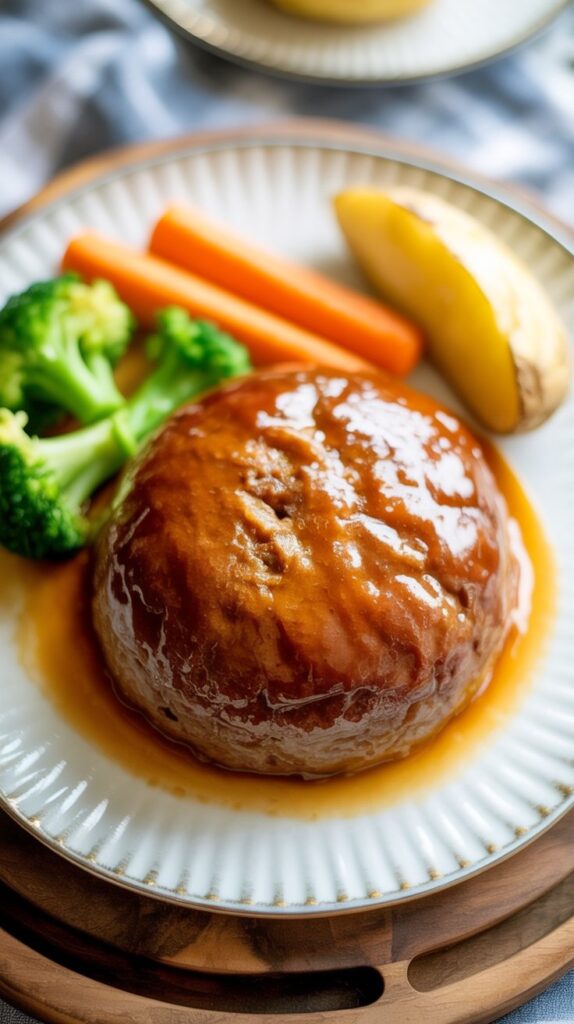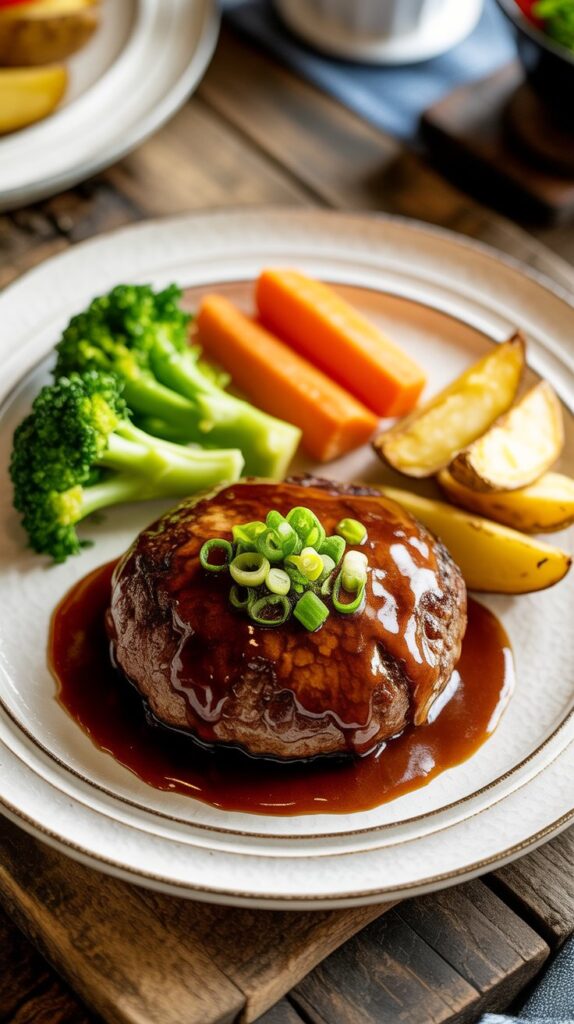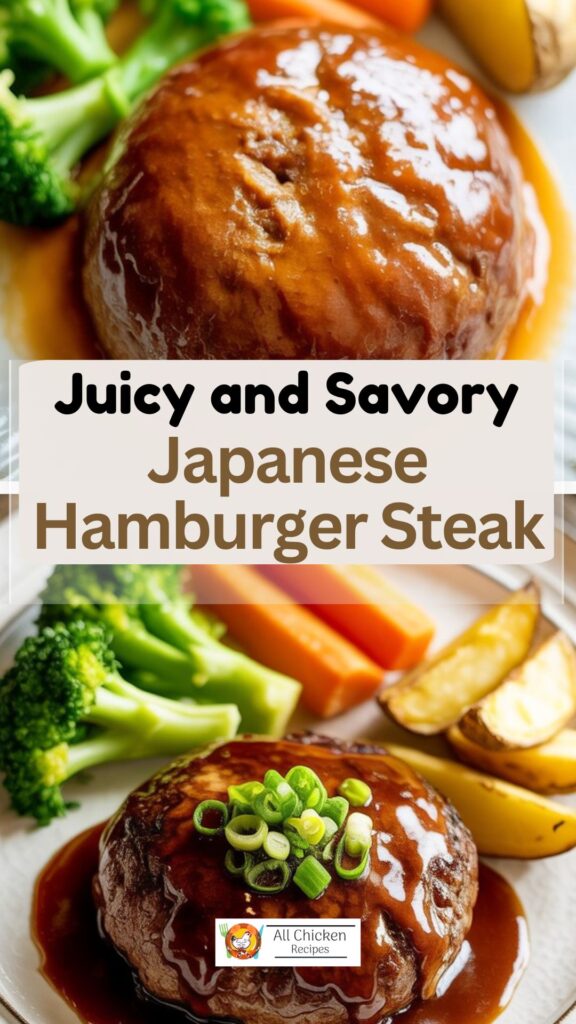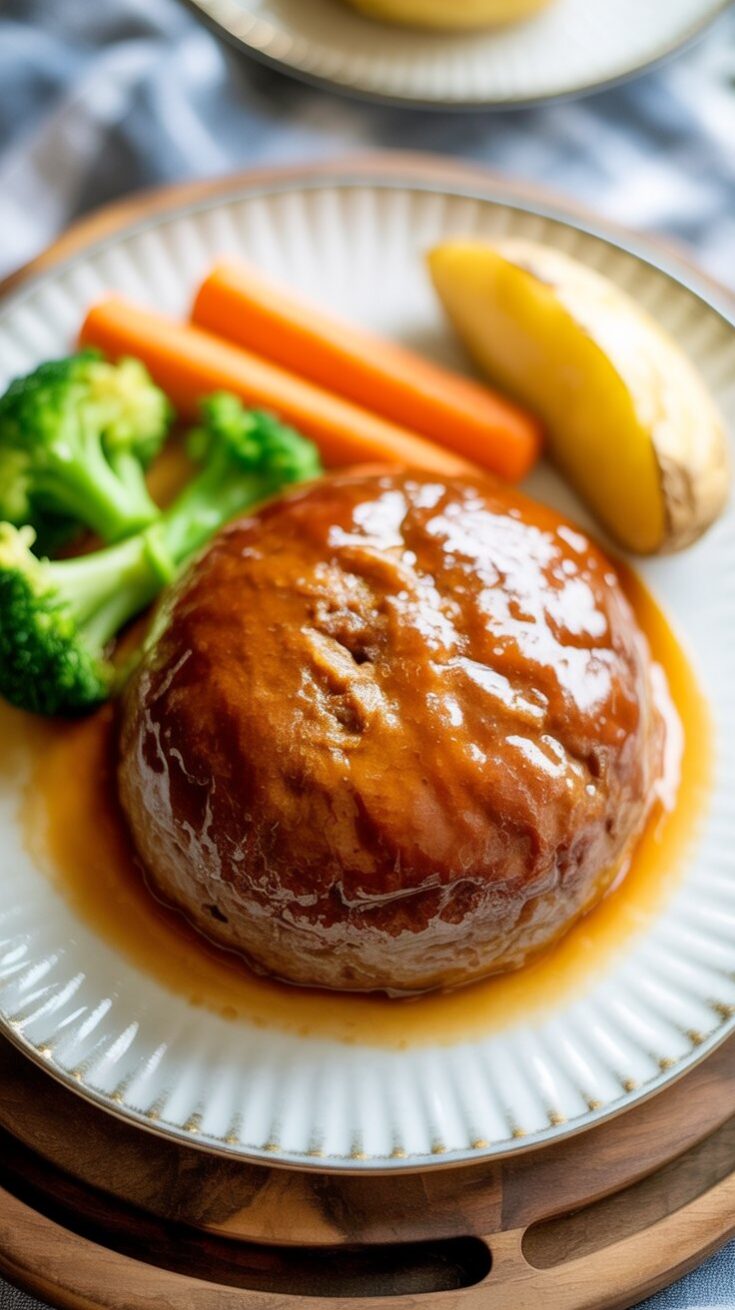If there’s one dish that always reminds me of comfort and family dinners, it’s this Japanese-style Hamburger Steak — or Hambagu, as it’s fondly called in Japan. It’s rich, tender, full of umami, and honestly feels like a warm hug on a plate. I make it when I want something special but still down-to-earth, the kind of meal that brings everyone to the table without needing a grand occasion.

Whether you’re serving it with rice and miso soup or keeping it simple with roasted veggies and potatoes, this is a dish that truly shines.
What Makes Hambagu So Special?
Hambagu isn’t your usual hamburger. It’s got more heart — literally and figuratively. Think of it like Japan’s answer to Salisbury steak, only juicier, softer, and loaded with flavor from the beef-pork blend and sweet onions.
I first tasted it at a cozy little diner tucked behind a train station in Kyoto. It was served on a sizzling plate with a mound of grated daikon and a fried egg on top. I’ve been hooked ever since. Back home, it became a regular in my kitchen — especially on rainy nights or lazy Sundays when I want something hearty but not too complicated.
A Quick Look at the Variations
You can find Hambagu across Japan, and every version tells a different story. There’s Wafu Hambagu with soy sauce and grated daikon, Teriyaki Hambagu, or even one drenched in a rich demi-glace. Some people like adding mushrooms, others top it with cheese or a fried egg. Honestly, it’s one of those recipes you can tweak endlessly, depending on what’s in your fridge or what mood you’re in.
Why I Use Both Ground Beef and Pork
This is one of those tricks I learned early on. In Japan, they sell a premixed blend of ground beef and pork called Aibiki Niku — and it’s a game-changer. The pork brings moisture and sweetness, while the beef gives that deep meaty flavor. I usually go for a 2:1 ratio of beef to pork, especially if I’m making a bigger batch for guests.
It’s the same combo I use for menchi katsu and even Japanese-style meat sauces. Trust me, once you try it, you’ll start mixing your ground meat more often.

Real-Life Tips for the Best Hambagu
I’ve made this dish more times than I can count, and these are the small things that make a huge difference:
- Cook your onions slowly: Don’t rush this step. That caramelized sweetness really deepens the flavor. I often sauté a big batch and freeze the extra for quick weekday meals.
- Mix until sticky: It sounds weird, but you want the meat to feel almost like a paste. That’s when you know it’ll hold together and come out tender.
- Toss the patties like you’re playing catch: Yes, really. I used to skip this until a friend told me it’s the only way to push out the air pockets. It makes the patties denser and less likely to fall apart.
- Chill before cooking: I let the patties sit in the fridge for at least 20 minutes. It helps firm them up and keeps the juices inside.
- Make a small indentation in the center: Just press down gently with your fingers before cooking — it prevents the patty from puffing up like a meatball.
- Use wine for steaming and the sauce: A splash of red wine goes a long way. If I don’t have wine, I’ll use a bit of beef broth with a spoon of Worcestershire sauce for that same rich depth.
- Deglaze with wine in the same pan: That sticky brown stuff in the pan? Don’t waste it. Scrape it up into your sauce for extra flavor.
If you don’t usually keep wine around, those little single-serving bottles are perfect. I keep a few in my pantry just for cooking.
How I Like to Serve It
There’s no wrong way to enjoy Hambagu, but here’s how it usually goes down at my place:
- Weeknight style: A couple of patties, steamed rice, miso soup, and a side of sautéed greens. That’s dinner done.
- Fancy weekend version: Crispy baked potato wedges, buttered carrots, and broccoli. Sometimes I’ll add a fried egg on top and pour the sauce over everything.
This dish always makes me feel like I’m eating at a little family-run diner in Tokyo — simple, satisfying, and cooked with care.
Make-Ahead & Storage Tips
Hambagu is great for prepping in advance. I often shape the patties, stack them between parchment, and freeze them raw. Then I just thaw and cook when I need a quick meal.
Leftovers? They keep well in the fridge for 3–4 days. Just reheat gently in a covered pan or microwave with a splash of water so they stay moist. The sauce tastes even better the next day.

FAQs
Can I make it with just beef?
Yes, but the texture will be firmer. Adding pork softens it and makes it juicier.
Can I bake it instead of pan-frying?
You can, but I’d still recommend searing the patties first for that golden crust, then finishing in the oven.
What can I use instead of red wine?
Beef stock with a little soy sauce or Worcestershire works well. Even grape juice can add that sweet acidity if you’re in a pinch.
Is it freezer-friendly?
Absolutely. I freeze raw patties in a zip bag with parchment in between. Cooked ones can also be frozen, just wrap them well and reheat gently.
Japanese Hamburger Steak

If you're craving something deeply comforting but with a Japanese twist, this homemade Hambagu is a total win. It’s tender, juicy, and seared to golden perfection—served with a savory red wine sauce that makes every bite feel extra special. This was one of those weekday recipes I fell in love with after the very first bite.
Ingredients
For the Patties
- ⅓ cup Japanese panko breadcrumbs
- 2 tablespoons milk
- 1 large egg
- ¾ lb ground meat (beef and pork mix; ideal ratio is 2:1 or 3:1)
- ½ teaspoon kosher salt
- ½ teaspoon ground nutmeg
- Freshly cracked black pepper, to taste
- ½ medium onion, finely minced
- 1 tablespoon neutral oil (for sautéing onion)
For Cooking the Patties
- 1 tablespoon neutral oil (for pan-searing)
- 3 tablespoons red wine (or beef/chicken stock for steaming)
For the Sauce
- 1 tablespoon unsalted butter
- 3 tablespoons red wine
- 3 tablespoons water
- 3 tablespoons ketchup (adjust to taste)
- 3 tablespoons tonkatsu sauce (or mix Worcestershire sauce with a bit of sugar)
Instructions
- Prepare the Patties: Start by finely mincing the onion. Heat some neutral oil in a pan over medium heat and sauté the onion until it's soft and translucent. Let it cool completely in a large mixing bowl.
- To the cooled onions, add the ground meat blend, salt, black pepper, and nutmeg. Then mix in the panko soaked briefly in milk, along with the egg. Start by stirring with a spatula, then use your hands to knead the mixture until it becomes sticky and well combined.
- Divide the meat mixture into 4 equal portions. Shape each into an oval patty, gently tossing them between your hands to remove air pockets. Press a small indent in the center of each one—this helps them cook evenly. Cover the patties and refrigerate for about 30 minutes to firm up.
- Cook the Patties: Heat a large skillet over medium heat with a bit of oil. Once hot, carefully place the patties into the pan. Let them brown undisturbed for about 3 minutes per side.
- Once seared, pour in the red wine (or stock), lower the heat, cover the pan, and let the patties steam for 5–7 minutes, depending on their thickness. To check if they're cooked through, insert a skewer—clear juices mean they’re done.
- Transfer the cooked patties to plates, but don’t wash the pan just yet.
- Make the Red Wine Sauce: In the same pan, melt butter over medium heat. Stir in the ketchup and tonkatsu sauce. Add wine and water, and bring it all to a simmer. Let it bubble gently until it thickens enough to coat the back of a spoon.
- Once glossy and rich, pour some of the sauce over each Hambagu and serve the rest on the side.
Notes
- This Japanese-style hamburger steak pairs beautifully with a scoop of steamed rice, some sautéed carrots, and a side of miso soup. For something a little extra, try baked potato wedges, steamed broccoli, or even a Japanese-style potato salad.
- Storage Tips: Leftover patties can be stored in an airtight container once fully cooled. They’ll stay good in the fridge for up to 3 days, or freeze well for up to a month. Reheat gently on the stove or in the microwave with a splash of water or stock to keep them moist.
Nutrition Information
Yield
4Serving Size
1Amount Per Serving Calories 458Total Fat 28gSaturated Fat 9gTrans Fat 1gUnsaturated Fat 16gCholesterol 141mgSodium 608mgCarbohydrates 17gFiber 1gSugar 6gProtein 29g
All Chicken Recipes.com, occasionally offers nutritional information for recipes contained on this site. This information is provided as a courtesy and is an estimate only. This information comes from online calculators. Although allchickenrecipes.com attempts to provide accurate nutritional information, these figures are only estimates.
Final Thoughts
This Japanese Hamburger Steak has become a go-to comfort meal in my kitchen — the kind you make once and crave again a week later. Whether you’re trying it for the first time or rediscovering an old favorite, I hope it finds a spot on your dinner table too.
Once you get the hang of the method, you can start experimenting with sauces and toppings. Some days it’s wafu-style with grated daikon, other days I go all out with mushrooms and demi-glace. That’s the beauty of Hambagu — it’s versatile, easygoing, and always satisfying.
Try Other Hamburger Recipes:
